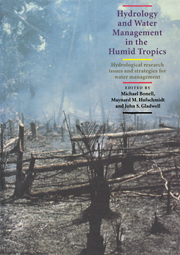 Hydrology and Water Management in the Humid Tropics
Hydrology and Water Management in the Humid Tropics Book contents
- Frontmatter
- Contents
- List of Authors
- Foreword by Federico Mayor, Director-General, UNESCO
- Preface
- Cartographic Credit
- Acknowledgements
- SECTION I INTRODUCTION
- SECTION II HUMID TROPICS SETTING
- SECTION III REGIONAL HYDROLOGY
- 5 Hydrology in Humid Tropical Asia
- 6 The Hydrology and Water Resources of Humid Northern Australia and Papua New Guinea
- 7 Hydrology and Water Resources of Tropical Latin America and the Caribbean
- 8 Amazonia Rainfall and Its Variability
- 9 Regional Hydrology and Water Resources in the African Humid Tropics
- 10 Review of Hydrology and Water Resources of Humid Tropical Islands
- SECTION IV PHYSICAL PROCESSES
- SECTION V PHYSICAL PROCESSES – HUMAN USES: THE INTERFACE
- SECTION VI MANAGEMENT ISSUES
- SECTION VII APPENDICES
- Place index
8 - Amazonia Rainfall and Its Variability
Published online by Cambridge University Press: 23 December 2009
- Frontmatter
- Contents
- List of Authors
- Foreword by Federico Mayor, Director-General, UNESCO
- Preface
- Cartographic Credit
- Acknowledgements
- SECTION I INTRODUCTION
- SECTION II HUMID TROPICS SETTING
- SECTION III REGIONAL HYDROLOGY
- 5 Hydrology in Humid Tropical Asia
- 6 The Hydrology and Water Resources of Humid Northern Australia and Papua New Guinea
- 7 Hydrology and Water Resources of Tropical Latin America and the Caribbean
- 8 Amazonia Rainfall and Its Variability
- 9 Regional Hydrology and Water Resources in the African Humid Tropics
- 10 Review of Hydrology and Water Resources of Humid Tropical Islands
- SECTION IV PHYSICAL PROCESSES
- SECTION V PHYSICAL PROCESSES – HUMAN USES: THE INTERFACE
- SECTION VI MANAGEMENT ISSUES
- SECTION VII APPENDICES
- Place index
Summary
ABSTRACT
The hydrological processes in Amazonia vary widely from year to year due to natural changes in the atmospheric conditions. This paper reviews the dynamic mechanisms that produce rainfall in the region, its characteristics and fluctuations due to inter-annual variability of the large-scale atmospheric circulations associated with the El Niño-Southern Oscillation phenomenon (ENSO) and blocking patterns of the atmospheric flow. It is hypothesized that the observed trends in precipitation, as well as runoff, reported by Rocha et al., (1989), may be related to a higher frequency of positive phases of ENSO and/or the presence of volcanic aerosols in the stratosphere over Amazonia. Such aerosols could influence the heating of the Andean Altiplano and, in turn, the seasonal development of the upper tropospheric anticyclone over tropical South America (Bolivian High). The effects of large-scale deforestation on local hydrology as well as the possible impacts on global climate are also discussed.
INTRODUCTION
The hydrologic cycle is an integrated product of the climate and of the biogeophysical attributes of the surface. On the other hand, it exerts an influence on climate which goes beyond the interaction between the atmospheric moisture, rainfall and runoff. It is the major single heat source for the atmosphere, in the form of latent heat which is released, mainly in the tropics, through the condensation of atmospheric moisture into clouds and rainfall.
Attempts to identify patterns in climatic fluctuations are mostly inconclusive because the climate, hence the hydrologic cycle, presents an intrinsic variability, both in space and time, which is not adequately known.
- Type
- Chapter
- Information
- Hydrology and Water Management in the Humid TropicsHydrological Research Issues and Strategies for Water Management, pp. 99 - 111Publisher: Cambridge University PressPrint publication year: 1993
- 12
- Cited by


